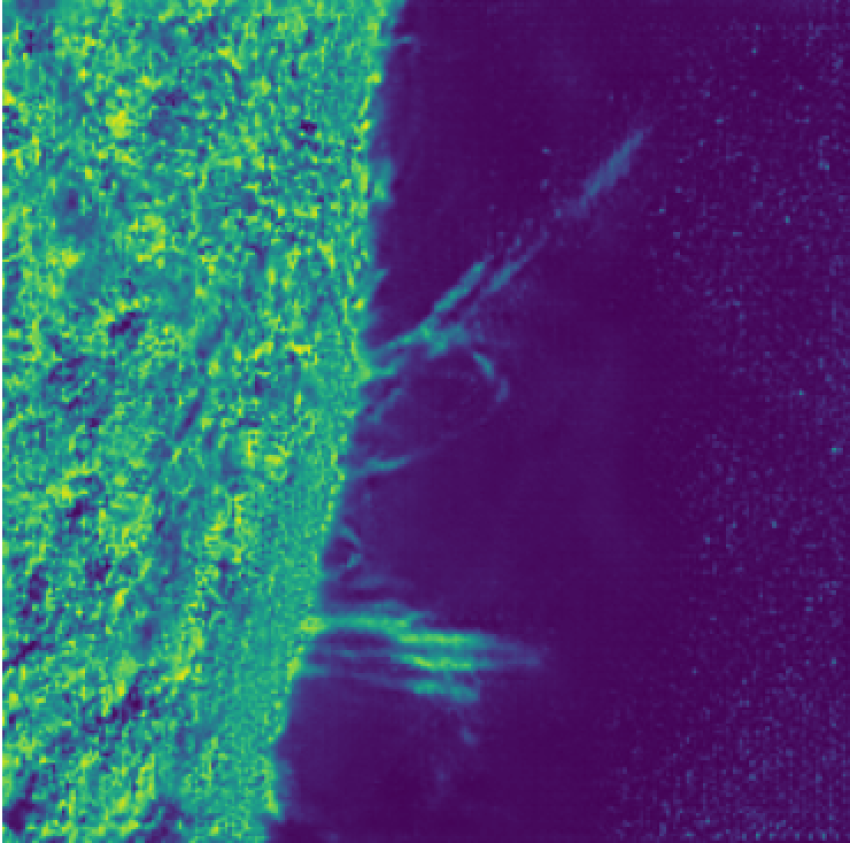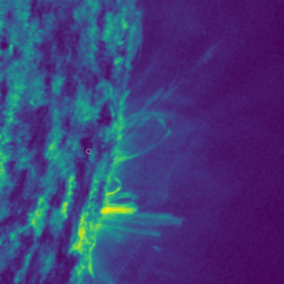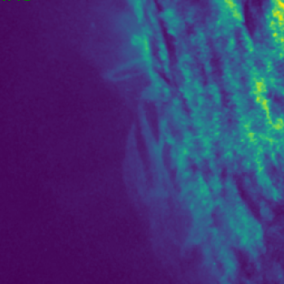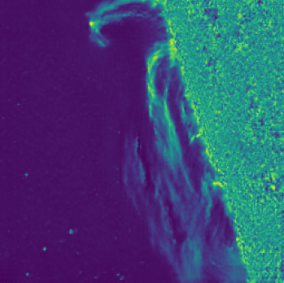Solar scientists are using deepfake AI images to unravel the mysteries of the Sun’s atmosphere. The research, being presented at the National Astronomy Meeting this week, was carried out as part of a collaboration between Northumbria University and the University of Bern.
For more than 80 years, solar physicists have been trying to understand how and why the upper reaches of the Sun’s atmosphere (the corona) are unexpectedly hotter than the layers closer to the surface. Scientists have narrowed it down to two possible causes: heating through the dissipation of waves in the plasma or through the energetic reconnection of magnetic lines. There is evidence for both happening but the amount that each process contributes to the total heating is still unknown.
The key to unlocking this mystery appears to lie in the beautiful phenomenon known as ‘coronal rain’ – loops of cooler plasma that project out and fall back into the upper reaches of the Sun’s atmosphere. Identifying this rain is vital in furthering our understanding of the Sun’s underlying thermodynamics. The ‘rain’ appears only to be generated by reconnecting magnetic lines. If scientists can find out how much coronal rain falls on the Sun, they can determine how this unexpected heating cycle works.
To find out how much rain there is, it must be observed separately from the myriad of other solar materials. Most observations of solar rain are taken by the Atmospheric Imaging Assembly (AIA) aboard NASA’s Solar Dynamics Observatory. However, the rain in these images is often obscured by hotter material. Alternative images taken by the Interface Region Imaging Spectrograph (IRIS), a NASA solar observation satellite, show the rain more clearly but can only capture a limited field of view. A Goldilocks set of images is needed in the high numbers of AIA with the sharp resolution of IRIS.
To solve this, researcher Luke McMullan from Northumbria University trained an AI machine learning algorithm to study the high-definition IRIS images and then enhance the more plentiful, lower-quality AIA images, creating ‘deepfakes’ that will allow astronomers to understand how much coronal rain falls in the Sun’s atmosphere and subsequently solve the mystery of its unusual heat layering.
“We are living in a golden age for solar research,” said Luke McMullan, the project’s lead researcher. “Not only are we obtaining access to more high-resolution images of the solar atmosphere than ever before, but the rapid development and implementation of machine learning techniques in tandem with these observations allow us to find answers to problems that have hounded the community for decades. We anticipate this collaboration between observations and machine learning only to grow deeper and become a staple tool in our scientific arsenal.”
Media Contacts
Megan Eaves
Royal Astronomical Society
press@ras.ac.uk
Gurjeet Kahlon
Royal Astronomical Society
Mob: +44 (0)7802 877 700
press@ras.ac.uk
Dr Robert Massey
Royal Astronomical Society
Mob: +44 (0)7802 877 699
press@ras.ac.uk
Science Contacts
Luke McMullan
Northumbria University
l.mcmullan@northumbria.ac.uk
Dr Patrick Antolin
Northumbria University
patrick.antolin@northumbria.ac.uk
Dr Brandon Panos
University of Bern
brandon.panos@unibe.ch
Images and captions
Image: image1-AIAoriginal.png
Caption: An original image of coronal rain loops taken by the Atmospheric Imaging Assembly (AIA) aboard NASA’s Solar Dynamics Observatory, showing the blurring from hotter material.
Credit: Luke McMullan / NASA Solar Dynamics Observatory
Image: image1-deepfake.png
Caption: Deep fake image of coronal rain generated by AI after studying a set of higher-resolution images from IRIS. Coronal rain loops are much more clearly visible.
Credit: Luke McMullan / NASA Solar Dynamics Observatory
Image: image2-AIAoriginal.png
Caption: Original image of coronal rain plasma projections taken by the Atmospheric Imaging Assembly (AIA) aboard NASA’s Solar Dynamics Observatory.
Credit: Luke McMullan / NASA Solar Dynamics Observatory
Image: image2-deepfake.png
Caption: AI-generated deepfake image of the same coronal rain with clearer resolution.
Credit: Luke McMullan / NASA Solar Dynamics Observatory
Image: image2-with-title-AIAoriginal.png
Caption: Same as above, with text title on photo
Credit: Luke McMullan / NASA Solar Dynamics Observatory
Image: image2-with-title-deepfake.png
Caption: Same as above, with text title on photo
Credit: Luke McMullan / NASA Solar Dynamics Observatory
Notes for editors
The NAM 2023 conference is principally sponsored by the Royal Astronomical Society (RAS), the Science and Technology Facilities Council (STFC) and Cardiff University.
About the Royal Astronomical Society
The Royal Astronomical Society (RAS, https://ras.ac.uk), founded in 1820, encourages and promotes the study of astronomy, solar-system science, geophysics and closely related branches of science. The RAS organises scientific meetings, publishes international research and review journals, recognises outstanding achievements by the award of medals and prizes, maintains an extensive library, supports education through grants and outreach activities and represents UK astronomy nationally and internationally. Its more than 4,000 members (Fellows), a third based overseas, include scientific researchers in universities, observatories and laboratories as well as historians of astronomy and others.
Follow the RAS on Twitter (https://twitter.com/royalastrosoc), Facebook (https://facebook.com/royalastrosoc), Instagram (https://instagram.com/royalastrosoc) and YouTube (https://www.youtube.com/channel/UCUZJ5FO9ayrmepOM4FHAASw)
About the Science and Technology Facilities Council
The Science and Technology Facilities Council (STFC) is part of UK Research and Innovation – the UK body which works in partnership with universities, research organisations, businesses, charities, and government to create the best possible environment for research and innovation to flourish. STFC funds and supports research in particle and nuclear physics, astronomy, gravitational research and astrophysics, and space science and also operates a network of five national laboratories, including the Rutherford Appleton Laboratory and the Daresbury Laboratory, as well as supporting UK research at a number of international research facilities including CERN, FERMILAB, the ESO telescopes in Chile and many more.
STFC's Astronomy and Space Science programme provides support for a wide range of facilities, research groups and individuals in order to investigate some of the highest priority questions in astrophysics, cosmology and solar system science. STFC's astronomy and space science programme is delivered through grant funding for research activities, and also through support of technical activities at STFC's UK Astronomy Technology Centre and RAL Space at the Rutherford Appleton Laboratory. STFC also supports UK astronomy through the international European Southern Observatory and the Square Kilometre Array Organisation.
Visit https://stfc.ukri.org/ for more information.
Follow STFC on Twitter: @STFC_Matters
About Cardiff University
Cardiff University is recognised in independent government assessments as one of Britain’s leading teaching and research universities and is a member of the Russell Group - the UK’s most research intensive universities. The 2021 Research Excellence Framework found 90% of the University’s research to be world-leading or internationally excellent. Among its academic staff are two Nobel Laureates, including the winner of the 2007 Nobel Prize for Medicine, Professor Sir Martin Evans. Founded by Royal Charter in 1883, today the University combines impressive modern facilities and a dynamic approach to teaching and research. The University’s breadth of expertise encompasses: the College of Arts, Humanities and Social Sciences; the College of Biomedical and Life Sciences; and the College of Physical Sciences and Engineering. Its University institutes bring together academics from a range of disciplines to tackle some of the challenges facing society, the economy, and the environment. More at www.cardiff.ac.uk





